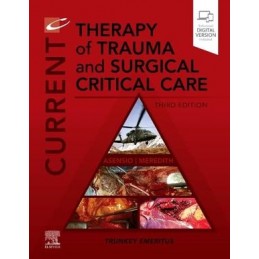- Reduced price

Order to parcel locker

easy pay


 Delivery policy
Delivery policy
Choose Paczkomat Inpost, Orlen Paczka, DHL, DPD or Poczta Polska. Click for more details
 Security policy
Security policy
Pay with a quick bank transfer, payment card or cash on delivery. Click for more details
 Return policy
Return policy
If you are a consumer, you can return the goods within 14 days. Click for more details
Data sheet
Part 1 Trauma Systems
1 Development of Trauma Systems
2 Trauma Center Organization and Verification for Current Therapy of Trauma and Surgical Critical Care
3 Injury Severity Scoring: Its Definition and Practical Application
4 Role of Alcohol and Other Drugs in Trauma
5 Injury Prevention: An Evidence-Based Public Health Approach
6 Lessons Learned in Military Trauma in Colombia
7 Trauma Scoring
8 Simulation-Based Training for Combat Surgery
Part 2 Prehospital Trauma Care
9 Prehospital Trauma Care: Influence of Emergency Medical Services on Trauma Center Patient Outcomes
10 Field Triage in the Military Arena
11 Trauma Systems on the Battlefield
12 Field Triage in the Civilian Arena
13 En Route Care
14 Prehospital Airway Management: Intubation, Devices, and Controversies
15 Prehospital Fluid Resuscitation: What Type, How Much, and Controversies
16 Mass Casualty Events: The Role of Hospitals and Trauma Systems
17 Injuries From Explosives
18 Prehospital Care of Biologic Agent-Induced Injuries
19 Wound Ballistics: What Every Trauma Surgeon Should Know
20 Common Prehospital Complications and Pitfalls in the Trauma Patient
Part 3 Initial Assessment and Resuscitation
21 Airway Management: What Every Trauma Surgeon Should Know, From Intubation to Cricothyroidotomy
22 Resuscitation Fluids
23 REBOA: Resuscitative Endovascular Balloon Occlusion of the Aorta
24 Resuscitative Thoracotomy
25 Focused Assessment with Sonography for the Trauma Patient Role of Radiology in Initial Trauma Evaluation
26 Interventional Radiology: Diagnostic and Therapeutic Roles
27 Interventional Radiology Management During Intermediate and Long-Term Phases of Trauma Care
28 Endpoints of Resuscitation 148
Part 4 Head and Central Nervous System Injuries
29 Traumatic Brain Injury: Pathophysiology, Clinical Diagnosis, and Prehospital and Emergency Center Care
30 Nonoperative Care, and Complications
31 Spinal Cord Injury, Blunt and Penetrating, Neurogenic and Spinal Shock
Part 5 Maxillofacial and Ocular Injuries
32 Maxillofacial Trauma
33 Trauma to the Eye and Orbit
Part 6 Neck Injuries
34 Penetrating Neck Injuries
35 Blunt Cerebrovascular Injuries
36 Tracheal, Laryngeal, and Oropharyngeal Injuries
Part 7 Thoracic Injuries
37 Pertinent Surgical Anatomy of the Thorax and Mediastinum
38 Thoracic Wall Injuries: Ribs, Sternal and Scapular Fractures, and Hemothoraces and Pneumothoraces
39 Diagnostic and Therapeutic Roles of Bronchoscopy and Video-Assisted Thoracoscopy in the Management of Thoracic Trauma
40 Pulmonary Contusion and Flail Chest
41 Operative Treatment of Chest Wall Injury
42 Tracheal and Tracheobronchial Tree Injuries
43 Operative Management of Pulmonary Injuries: Lung-Sparing and Formal Resections
44 Complications of Pulmonary and Pleural Injury
45 Cardiac Injuries
46 Thoracic Vascular Injury
47 Thoracic Aortic Injury
48 Esophageal Injuries: Principles of Management
Part 8 Abdominal Injuries
49 Diaphragmatic Injury
50 Surgical Anatomy of the Abdomen and Retroperitoneum
51 Diagnostic Peritoneal Lavage and Laparoscopy in the Evaluation of Abdominal Trauma
52 Nonoperative Management of Blunt and Penetrating Abdominal Injuries
53 Gastric Injuries
54 Small Bowel Injury
55 Duodenal Injuries
56 Pancreatic Injuries and Pancreaticoduodenectomy
57 Liver Injury
58 Splenic Injuries
59 Abdominal Vascular Injury
60 Colon and Rectal Injuries
61 Genitourinary Tract Injuries
62 Gynecologic Injuries: Trauma to Uterus, Ovaries, and Female Genitalia
Part 9 Special Issues in Major Torso Trauma
63 Multidisciplinary Management of Pelvic Fractures: Operative and Nonoperative Management
64 Current Concepts in the Diagnosis and Management of Hemorrhagic Shock
65 Exsanguination: Reliable Models to Indicate Damage Control
66 Damage Control Resuscitation: An Evidence-Based Report
67 Newer Strategies from the Use of Blood and Blood Products: Lessons Learned from Recent Wars
68 Surgical Techniques for Damage Control Operations for Abdominal, Thoracic, Pelvic, and Extremity Trauma
69 Abdominal Compartment Syndrome, Damage Control, and the Open Abdomen
70 Torso Trauma on the Modern Battlefield
Part 10 Peripheral Vascular Injury
71 Vascular Anatomy of the Extremities
72 Diagnosis of Vascular Trauma
73 Penetrating Carotid Artery Injuries
74 Penetrating Extracranial Vertebral Artery Injuries
75 Subclavian Vessel Injuries: Difficult Anatomy and Difficult Territory
76 Operative Exposure and Management of Axillary Vessel Injuries
77 Brachial Vessel Injuries: High Morbidity and Low Mortality Injuries
78 Iliac Vessel Injuries: Difficult Injuries and Difficult Management Problems
79 Femoral Vessel Injuries: High Mortality and Low Morbidity Injuries
80 Popliteal Vessel Injuries: Complex Anatomy and High Amputation Rates
81 Shank Vessel Injuries: The Forgotten Vascular Injuries
82 Penetrating Arteriovenous Fistulas: Uncommon and Challenging Entities
83 Temporary Vascular Shunts
Part 11 Musculoskeletal and Peripheral Central Nervous System Injuries
84 Upper Extremity Fractures: Orthopedic Management
85 Lower Extremity and Degloving Injury
86 Cervical, Thoracic, and Lumbar Spine Fractures
87 Pelvic Fractures
88 Wrist and Hand Fractures: Orthopaedic Management Scapulothoracic Dissociation and Degloving Injuries of the Extremities
89 Extremity Replantation: Indications and Timing
Part 12 Special Issues and Situations in Trauma Management
90 Flap Reconstruction in the Management of Complex Musculoskeletal Injuries
91 What Every Surgeon Should Know About the Traumatic Airway
92 Pediatric Trauma
93 Trauma in Pregnancy
94 Trauma in Our “Elders”
95 Burns
96 Soft Tissue Infections
97 Common Errors in Trauma Care
98 Combat Trauma Care: Lessons Learned From Recent Combat Operations
99 Danger Associated Molecular Patterns, Complements, and Other Novel Biomarkers in Trauma Patient Management
100 Microbiome and Trauma
101 Genomics of Profound Shock and Trauma
Part 13 Critical Care I: Management of Organ Failures and Techniques for Support
102 Cardiac Hemodynamics: Pulmonary Artery Catheter and the Meaning of Its Readings
103 Oxygen Transport
104 Pharmacologic Support of Cardiac Failure
105 Diagnosis and Management of Cardiac Dysrhythmias
106 Fundamentals of Mechanical Ventilation
107 Advanced Techniques in Mechanical Ventilation
108 Acute Kidney Injury and Renal Replacement Therapy in the Surgical Intensive Care Unit
109 Management of Coagulation Disorders in the Surgical Intensive Care Unit
110 Management of Endocrine Disorders in the Surgical Intensive Care Unit
111 Transfusion: Management of Blood and Blood Products in Trauma
Part 14 Critical Care II: Special Issues and Treatments
112 Thromboelastography: Techniques and Uses
113 Acute Respiratory Distress Syndrome
114 The Evolving Epidemiology of Multiple Organ Failure
115 Sepsis, Septic Shock, and Its Treatment
116 The Immunology of Trauma
117 Overview of Infectious Diseases in Trauma Patients
118 Nosocomial Pneumonia
119 Antibiotic Use in the Intensive Care Unit: The Old and the New
120 Fungal Colonization and Infection During Critical Illness
121 Preoperative and Postoperative Nutritional Support: Strategies for Enteral and Parenteral Therapies
122 Venous Thromboembolic Events: Diagnosis, Treatment, and Filters as Adjuncts
123 Hypothermia and Trauma
124 Surgical Procedures in the Surgical Intensive Care Unit
125 Anesthesia in the Critical Care Unit and Pain Management
126 Anesthesia Adjuncts in the Management of Pain in Trauma Patients: New Blocks and Other Techniques to Combat the Opioid Epidemic
127 Extracorporeal Membrane Oxygenation for Acute Cardiopulmonary Failure
Part 15 Rehabilitation and Quality of Life After Trauma and Other Issues
128 Surgery During Global Pandemics: Focus on Prioritization and Resource Allocation
129 Diagnostic Management of Brain Death in the Intensive Care Unit and Organ Donation
130 Palliative Care in the Trauma Intensive Care Unit
131 Trauma rehabilitation
132 Trauma outcomes
